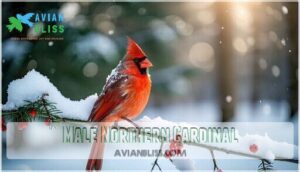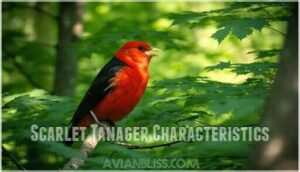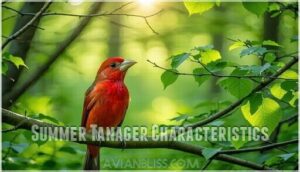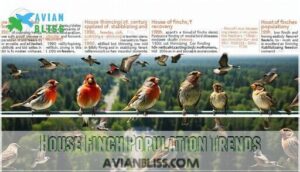This site is supported by our readers. We may earn a commission, at no cost to you, if you purchase through links.

The Northern Cardinal reigns as the state’s most common red bird, with males sporting brilliant crimson plumage and distinctive black masks year-round.
Scarlet Tanagers flash like living rubies through summer forests, while Summer Tanagers bring tropical warmth to woodland edges.
House Finches add cheerful red splashes to suburban feeders, and Red-bellied Woodpeckers surprise newcomers with their striking red caps despite their misleading name.
These vibrant species thrive across Pennsylvania’s diverse habitats, from backyard feeders to mature forests, and each species has unique identification markers and seasonal patterns that separate seasoned birders from weekend enthusiasts, making birdwatching adventures and understanding of seasonal patterns key to the experience.
Table Of Contents
- Key Takeaways
- Red Birds Overview
- Pennsylvania Bird Species
- Red Bird Habitats
- Red Bird Identification
- Red Bird Population Trends
- Frequently Asked Questions (FAQs)
- What are the bright red birds in Pennsylvania?
- What’s the difference between a red bird and a cardinal?
- What is the most common red bird?
- What is the rarest bird in Pennsylvania?
- What red birds stay in Pennsylvania year-round?
- When do red birds typically nest and breed?
- What seeds attract red birds to feeders?
- How do red birds survive Pennsylvania winters?
- Which red birds are endangered or declining?
- Conclusion
Key Takeaways
- You’ll spot five main red bird species in Pennsylvania: Northern Cardinals (year-round residents), Scarlet and Summer Tanagers (seasonal visitors), House Finches (backyard regulars), and Red-bellied Woodpeckers (common residents with distinctive red caps).
- Northern Cardinals are your most reliable sightings since they don’t migrate – you’ll find males with brilliant crimson plumage and black masks at backyard feeders throughout winter, while females display warm brown coloring with red highlights.
- You’ll have better luck finding Scarlet and Summer Tanagers during breeding season (May through July) in mature forests, where they prefer the canopy level and feed primarily on insects rather than visiting feeders.
- Different habitats attract different species – Cardinals and House Finches frequent backyard feeders and suburban areas, while tanagers stick to forest edges and mature woodlands, so you’ll need to explore various locations for complete red bird sightings.
Red Birds Overview
Pennsylvania’s diverse landscapes provide perfect homes for at least 12 species of red birds, from the iconic Northern Cardinal to the forest-dwelling Scarlet Tanager.
Whether you’re scanning your backyard feeder or exploring mature woodlands, you’ll discover these crimson beauties offer year-round viewing opportunities and fascinating behaviors that’ll keep any bird enthusiast coming back for more.
Northern Cardinal
The Northern Cardinal stands as Pennsylvania’s most recognizable red bird, with males sporting brilliant crimson plumage year-round.
You’ll spot these non-migratory beauties at backyard feeders throughout winter, where their Cardinal Diet includes seeds and berries.
These winter warriors brighten the coldest days with their brilliant red feathers and cheerful presence.
- Cardinal Song: Males whistle clear "birdy-birdy-birdy" notes during Mating Rituals
- Winter Flocking: Small groups forage together in cold months
- Backyard Attractants: Sunflower seeds and safflower attract cardinals consistently
- Year-round residents: Unlike migratory red birds Pennsylvania hosts seasonally
Scarlet Tanager
One crimson flash through Pennsylvania’s forest canopy reveals the scarlet tanager, a stunning red bird identification challenge for many birdwatchers.
These Pennsylvania birds prefer mature forests during breeding season, with males displaying brilliant red plumage details against black wings.
Their tanager diet consists mainly of insects gleaned from treetops, and scarlet migration patterns bring them here seasonally, though their conservation status remains stable across bird species Pennsylvania populations.
Summer Tanager
Beauty defines the Summer Tanager’s appeal among Pennsylvania birds.
You’ll spot males displaying brilliant red plumage year-round, while females showcase golden-yellow feathers with subtle orange tinges.
Their Summer Tanager Diet consists mainly of bees, wasps, and fruits.
These bird species Pennsylvania residents love inhabit mature forests during breeding season, with Nesting Habits involving cup-shaped structures in oak trees.
Tanager Migration patterns bring them here from Central America each spring, showcasing their unique breeding season habits.
House Finch
House finches bring year-round color to your backyard birds Pennsylvania experience. These adaptable songsters aren’t true migrants—they’ll stick around through winter, making them reliable residents in your Pennsylvania bird guide.
These reliable winter residents add vibrant crimson to snow-covered feeders when other birds head south.
You’ll spot males wearing rosy-red plumage on their heads and chests, while females sport brown streaking.
5 House Finch Facts That’ll Make You Appreciate These Feathered Neighbors:
- Their diet flexibility amazes scientists—House Finch Diet includes seeds, buds, fruits, and occasionally insects
- They’re disease survivors—Finch Diseases like conjunctivitis once threatened populations, but they’ve bounced back
- Their western origins surprise many—originally from western North America before expanding eastward
- Finch Adaptations include strong beaks—perfectly designed for cracking tough seeds
- Finch Conservation efforts helped them thrive—now common across Pennsylvania’s diverse habitats
When bird watching Pennsylvania locations, listen for their warbling songs. These house finch champions prove that sometimes the most common species deserve our attention.
They’ll visit your feeders regularly, especially if you offer sunflower seeds. To identify red bird species correctly, remember that male house finches show more orange-red coloring compared to the brilliant red of cardinals.
Red-bellied Woodpecker
Moving from finches to woodpeckers, you’ll spot Red-bellied Woodpeckers among Pennsylvania’s common red birds through their distinctive drumming behavior on tree trunks.
These adaptable backyard birds Pennsylvania residents love show impressive diet adaptations, eating insects, fruits, and nuts.
Their conservation status remains stable despite habitat loss concerns.
You’ll find their nesting habits fascinating—they excavate cavities in dead wood.
Perfect targets for bird watching Pennsylvania enthusiasts seeking red bird sightings in Pennsylvania wildlife areas.
Pennsylvania Bird Species
Throughout the year, Pennsylvania wildlife enthusiasts can spot at least 12 species commonly called red birds, making the state a true haven for colorful avian observations.
These common red birds showcase remarkable diversity in their appearances, behaviors, and ecological roles across Pennsylvania’s varied landscapes.
The state’s red bird sightings include these notable species:
- Northern Cardinals – Year-round residents with steadily increasing populations
- Scarlet and Summer Tanagers – Seasonal visitors during breeding months
- House Finches – Adaptable backyard regulars with variable red coloring
- Red-bellied and Red-headed Woodpeckers – Cavity-nesting specialists
Bird Conservation efforts have documented how Regional Variations in climate and habitat influence these species’ distributions. The Northern Cardinal’s population growth reflects successful adaptation to Pennsylvania’s changing environment, while tanagers demonstrate seasonal migration patterns tied to Nesting Habits in mature forests.
Pennsylvania also hosts diverse birds of prey that play key roles in the ecosystem. Understanding Avian Diet preferences and Bird Songs helps distinguish between species, as each has evolved unique feeding strategies and vocal patterns that match their specific red bird habitat requirements throughout Pennsylvania’s diverse ecosystems.
Red Bird Habitats
You’ll find Pennsylvania’s red birds thriving in diverse habitats that match their feeding and nesting needs perfectly.
From the Northern Cardinals at your backyard feeders to Scarlet Tanagers hidden in mature forest canopies, each species has carved out its preferred niche across the state’s varied landscape, allowing them to coexist with other species in a delicate balance of ecosystem.
Forest Edges
Forest edges create prime red bird habitat where woodlands meet open spaces.
You’ll find Scarlet Tanagers and Summer Tanagers thriving in these boundary zones during breeding season.
Edge effects boost habitat diversity and species interactions, making these areas hotspots for bird identification guide enthusiasts.
Conservation efforts focus on protecting these vital boundaries from human impact to preserve species interactions.
Backyard Feeders
If you’re hoping to spot red birds right outside your window, backyard feeders are your ticket.
You’ll catch Northern Cardinals, House Finches, and even the occasional Purple Finch if you set things up right.
Try these tips:
- Offer mixed seeds for diverse red bird diet
Backyard feeders can benefit from high quality options.
- Experiment with feeder types
- Practice squirrel control
- Keep a bird identification guide handy
Mature Forests
Deep within Pennsylvania’s old-growth forests, you’ll discover prime RED bird territory where forest biodiversity thrives.
The complex canopy structure provides perfect nesting spots for Scarlet and Summer Tanagers, while purple finch populations flourish in these undisturbed habitats.
Forest conservation efforts protect these mature woodlands from habitat fragmentation, ensuring red bird migration patterns remain stable and their specialized red bird diet needs are met year-round.
The preservation of these forests relies on understanding forest habitat diversity to maintain the delicate ecosystem.
Edge Habitats
Edge habitats create perfect conditions for spotting Pennsylvania’s red birds.
When forests meet fields, you’ll discover nature’s sweet spot where different ecosystems blend.
Forest fragmentation actually benefits species like Northern Cardinals, whose populations have thrived thanks to increased boundary effects.
Here’s what makes edge habitats special:
- Mixed vegetation provides diverse food sources year-round
- Varied nesting sites accommodate different red bird preferences
- Natural corridors support red bird migration patterns
- Enhanced biodiversity preservation creates healthier ecosystems
These intermediate zones promote ecological balance while offering prime birdwatching opportunities.
Red Bird Identification
You’ll find identifying red birds in Pennsylvania surprisingly straightforward once you know what to look for.
Each species has distinct features that make spotting them a rewarding experience for both beginners and seasoned birdwatchers, with distinct features being key to their identification.
Male Northern Cardinal
You’ll recognize a male Northern Cardinal instantly – his vivid red plumage creates stunning contrast against winter snow or summer greenery.
This crimson beauty sports a distinctive black mask around his bill and eyes, plus a prominent crest that signals his mood.
His bright coloring serves dual purposes: attracting mates and establishing territory through community partnerships with other cardinals.
Listen for his clear whistled songs echoing through neighborhoods, promoting awareness of his presence.
His red feathers require careful feather care, staying vibrant year-round to maintain health.
The Northern Cardinal’s popularity has led to various cardinal gift options being available for enthusiasts.
Female Northern Cardinal
You’ll spot female Northern Cardinals by their warm tan plumage with striking red highlights on wings, tail, and crest.
Unlike their vibrant male counterparts, females showcase subtle beauty that serves as perfect camouflage during nesting habits.
Their Cardinal diet includes seeds and insects, supporting community health awareness.
Listen for their distinctive song patterns while they practice fastidious feather care, advocating for wildlife conservation through their graceful presence.
The northern cardinal species profile reveals fascinating insights into their bird conservation status.
Scarlet Tanager Characteristics
You’ll instantly recognize male Scarlet Tanagers by their brilliant red plumage color contrasted with jet-black wings and tail.
These Pennsylvania birds showcase thick, pale beaks perfect for catching insects mid-flight. During breeding season, their robin-like song patterns echo through mature forests.
Female Scarlet Tanagers display olive-yellow coloring with darker wings. Their nesting habits favor tall oak trees, while migration routes extend to South American wintering grounds each fall.
Observing the Scarlet Tanager’s behavior can help with understanding bird species identification and learning about their unique characteristics and migration routes.
Summer Tanager Characteristics
Summer tanagers bring tropical elegance to Pennsylvania’s mature forests, where these red birds create unforgettable wildlife encounters.
Unlike their scarlet cousins, males sport rose-red plumage year-round, while females wear golden-yellow feathers that catch sunlight beautifully.
- Beak Shape: Thick, pale bills perfectly designed for catching wasps and bees mid-flight
- Bird Song: Melodic robin-like phrases that echo through summer habitat canopies
- Feather Patterns: Males display solid rose-red coloring without black wings or tail
- Tanager Migration: These pennsylvania visitors arrive in May and depart by early September
Red Bird Population Trends
You’ll notice fascinating changes in Pennsylvania’s red bird populations over the decades, with Northern Cardinals showing the most dramatic increase throughout the twentieth century.
These shifts reflect how birds adapt to changing landscapes, from expanding suburban feeders to warming winter temperatures that help year-round residents thrive, and demonstrate how birds adapt to their environments.
Northern Cardinal Population
You’ll find Northern Cardinals thriving throughout Pennsylvania, with their population growth reflecting a remarkable conservation success story.
Since 1900, these red birds have expanded across all 67 counties, boosting numbers by over 15% since 1970.
Cardinal behavior adapts well to habitat expansion in suburban areas, where backyard feeders support their varied cardinal diet and nesting patterns within our growing community.
The Northern Cardinals’ ability to thrive is also attributed to their bird feeder preferences and adaptability.
Scarlet Tanager Migration
When October arrives, you’ll witness one of nature’s most remarkable journeys as Scarlet Tanagers begin their epic migration from Pennsylvania’s forests to South American wintering grounds.
These red birds undertake an incredible 4,000-mile odyssey that showcases the marvels of avian ecology. The Scarlet Tanagers’ survival depends on effective conservation efforts to protect their habitats.
Here’s what makes their seasonal movements so fascinating:
- Migration patterns follow a loop route through the Gulf of Mexico and Central America
- Bird tracking reveals stopovers lasting 2-10 days at key refueling sites
- Tanager habitat shifts from Pennsylvania’s mature forests to tropical South American forests
- Peak departure occurs in early October after post-breeding molt completion
- Nocturnal travel covers vast distances under cover of darkness for protection
Summer Tanager Breeding Season
When you’re exploring Pennsylvania’s red birds during summer, timing matters for spotting these elusive tanagers.
Summer Tanager breeding season runs from June through July, making these months your best bet for observing their fascinating breeding habits and tanager mating displays.
Males arrive first to establish territories, followed by females who handle bird nesting duties.
Their summer diet consists mainly of insects, which they catch to feed hungry chicks in Pennsylvania’s oak forests.
House Finch Population Trends
House Finch populations in Pennsylvania have experienced dramatic ups and downs since their introduction.
You’ll witness fascinating Population Growth patterns that mirror a roller coaster ride through decades of Bird Counts and research.
5 Key House Finch Population Trends:
- Explosive expansion – Mid-20th century introduction led to rapid Finch Migration eastward
- Peak abundance – Mid-1990s marked maximum numbers in Urban Birds communities
- Disease devastation – Mycoplasmal conjunctivitis outbreak caused steep declines affecting community health
- Density-dependent decline – Highest losses occurred where Finch Habitat supported densest populations
- Stabilized recovery – Current numbers remain steady but below historical peaks, supporting ongoing education and advocacy efforts
Frequently Asked Questions (FAQs)
What are the bright red birds in Pennsylvania?
You’ll spot Northern Cardinals year-round – vibrant red males with black masks and crested females with red highlights. Scarlet Tanagers and Summer Tanagers visit during breeding season in mature forests.
What’s the difference between a red bird and a cardinal?
Like Audubon’s field guides distinguish species, "red bird" is a casual term for any crimson-colored bird.
While "cardinal" specifically refers to Northern Cardinals—Pennsylvania’s iconic crested songbird with males displaying brilliant red plumage and distinctive black facial masks.
What is the most common red bird?
The Northern Cardinal is America’s most common red bird.
You’ll find these vibrant crimson songbirds across nearly every backyard in the eastern United States, making them the quintessential "red bird" most people recognize.
What is the rarest bird in Pennsylvania?
Rare as a needle in a haystack, Pennsylvania’s piping plover stands as the state’s rarest bird, classified as endangered.
You’ll find these tiny shorebirds clinging to existence with fewer than a few pairs returning to nest at Presque Isle annually since
What red birds stay in Pennsylvania year-round?
You’ll find Northern Cardinals as your most reliable year-round red residents.
These non-migratory birds maintain Pennsylvania territories through all seasons, with males displaying brilliant crimson plumage and distinctive black masks year-round, making them a notable sight due to their distinctive appearance.
When do red birds typically nest and breed?
Most red species begin nesting in early March through April, with peak breeding during May through July.
Cardinals start second clutches during this time, while house finches breed from early spring through summer.
What seeds attract red birds to feeders?
You’ll stock your feeder with black oil sunflower seeds for guaranteed cardinal visits. Safflower seeds work exceptionally well too, plus squirrels typically ignore them, leaving more for your feathered friends.
How do red birds survive Pennsylvania winters?
You’ll find Northern Cardinals and other red birds weathering Pennsylvania’s harsh winters through several clever adaptations.
They fluff their feathers for insulation, huddle together for warmth, and rely on fat reserves built up during fall feeding.
Which red birds are endangered or declining?
Strikingly, the Scarlet Tanager ranks among 84 species threatened by climate change in Pennsylvania.
You’ll find most red birds like Cardinals thriving, but Evening Grosbeaks face significant decline in their winter populations.
Conclusion
Spectacular sightings of red birds in pennsylvania await dedicated observers who venture beyond their backyards.
You’ll find these crimson creatures inhabiting diverse ecosystems throughout the state, from dense woodlands to suburban neighborhoods.
Northern Cardinals remain year-round residents, while tanagers bring seasonal excitement during breeding months.
Each species offers unique identification challenges that’ll sharpen your birding skills.
Remember to pack patience and binoculars—these vibrant birds reward careful observation with unforgettable encounters that’ll keep you returning to Pennsylvania’s rich avian landscapes.
- https://flyaviary.com/types-of-red-birds-in-pennsylvania/
- https://www.skh.com/blog/common-backyard-birds-in-pa/
- https://www.pa.gov/agencies/pgc/wildlife/discover-pa-wildlife/tanagers.html
- https://tylerarboretum.org/announcing-the-3rd-pennsylvania-bird-atlas/
- https://www.allaboutbirds.org/guide/House_Finch/overview













